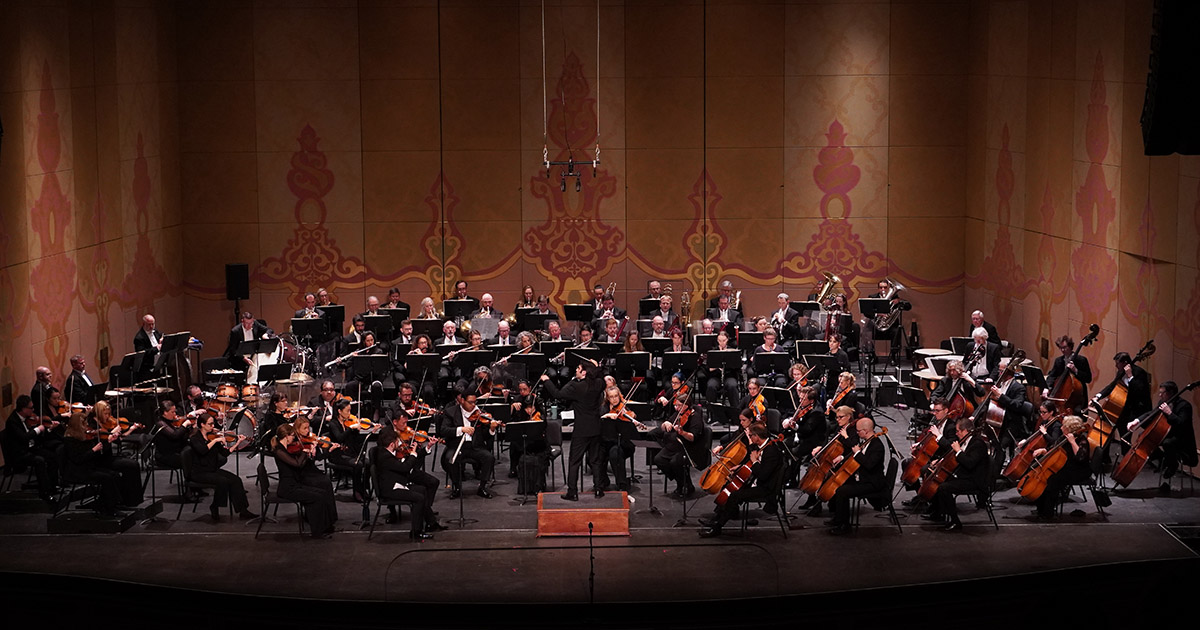Going big in a season finale symphony concert is, most assuredly, a valid approach, one that the Knoxville Symphony Orchestra and conductor Aram Demirjian embraced this weekend to finish up the 2022-23 concert season. In this case, “big” meant not only a super-sized orchestral performance of Stravinsky’s The Rite of Spring (Le Sacre du Printemps), but also big in the entertainment value from three other works: Lili Boulanger’s Of a Spring Morning, contemporary Tan Dun’s Passacaglia: Secret of Wind and Birds, and Beethoven’s Piano Concerto No. 4 in G Major.
KSO season finale concerts inevitably have a strong emotional underpinning, owing to the orchestra’s upcoming summer break of almost four months, a period in which some orchestra members take summer gigs near and far, and others just take time off. The orchestra also uses the occasion to recognize members’ performance milestones—this year from 5 to 40 years. Also inevitable are the pangs of nostalgia that regular concert-goers feel for the season as they await a new season in September.
Maestro Demirjian’s intriguing program had a natural gravity and progression to it, with the listener being pulled relentlessly toward the Stravinsky on the second half under a general thematic umbrella of “spring.” He opened with a short work by Lili Boulanger, D’un matin de printemps (Of a Spring Morning), one of the last completed works in this promising composer’s short life. Dying tragically at age 24, she was the younger sister of Nadia Boulanger, the noted educator of many American composers from Aaron Copland to Philip Glass.
Composed in the same period of European turmoil as The Rite of Spring, D’un matin de printemps is everything that the Stravinsky is not: bright, light, and blissfully optimistic with the lushness of French Impressionism touches from strings and woodwinds, glowingly accomplished by the KSO players.
Continuing the concept of spring, Demirjian found a piece that not only embraces the idea of birdsong as an essential sonic texture of spring, but also one that embraces our modernity. Passacaglia: Secret of Wind and Birds, by Chinese composer Tan Dun, commissioned by the National Youth Orchestra and Carnegie Hall, was an audience participation piece created by recording bird calls performed on Chinese instruments, then made available to download to one’s smartphone. The audience was invited to link to an online file and “perform” with the orchestra on cue. Of course, getting a room full of human beings to undertake something new, understand the gist of it, and follow directions is tantalizingly risky. But then again, the elements of chance and variation can be equally entertaining, which, on this concert, it certainly was. As the smartphone moment fades, the orchestra takes over with a wide variety of whispered chants, percussion effects, and jungle-dense substance from lush strings and brass.

Finishing up the first half of the evening was a performance of Beethoven’s Piano Concerto No. 4 in G Major with pianist Zhenni Li-Cohen. While more accurately a side trip rather than a part of the evening’s gravity, the concerto was the perfect choice to reflect the program’s emotional underpinning. Li-Cohen’s attention to expressive detail was stunning with melodic passages receiving an intense revealing of depth, and surprising twists and turns that kept the listener on the edge of his/her seat. Some of the surprise came with her luxurious and extensive use of rubato that opened up florid phrases to new meaning and pulled and tugged at the orchestra and listener in a battle of wills. Admittedly, I could not help fearing the piano and orchestra might stumble as a result, but togetherness precipices were avoided, leaving the listener practically gasping for breath at the conclusion.
While the length of the program probably prevented Li-Cohen from performing an encore on the Friday evening performance, she eagerly provided the Thursday audience with a stunning take on Gershwin’s “The Man I Love” arranged for just the left-hand.
If one goal of a season-ending concert is to send the audience off into the night having been sonically fulfilled, then Stravinsky’s The Rite of Spring certainly fills the bill. With the concert hall stage radiating with color from extra flutes, oboes, clarinets, bassoons, brass, and percussion, the work is a showcase of instrumental variety that Stravinsky used to create a raw, visceral landscape of primeval emotions.
For a 2023 audience accustomed to modern dance, imagining this sonically-textured work—and its reputation for earthy sexuality—in its original ballet form takes a bit of work. In this performance, super-titles with programmatic descriptions were provided in an effort to provide the balletic context, a context that is both unsettling and enticing.
This performance by Demirjian and the orchestra—beautiful in its restrained savagery—was a satisfying example of an excellent ensemble at work, focused on creating a meaningful musical narrative out of Stravinsky’s complex and hauntingly violent score. The narrative was delivered as if it was evoking a memory from some distant past, something vaguely familiar recalled from some long ago time and mysterious place. This approach used the dissonance and irregular meters as tools, the inertia being naturally broken, countered, and changed, allowing quieter regular moments to acquire some kind of different meaning in contrast.
So, two artistic versions of spring from the KSO: one lyrical and idyllic; the other, raw and violent in its reawakening. Perhaps, we exist somewhere in between, aiming for a just civilization, but always reminded of our earthy and physical past. No doubt, this conversation and debate will continue next season.








